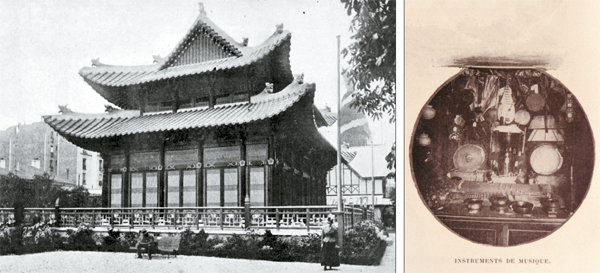France returns instruments for an exhibit of note

Folk musicians (left) and court musicians (right) of the early 20th century are seen in these photos. Old musical instruments that are well-preserved and whose origins are known are a rarity in Korea, according to museum officials. Provided by the museum
France and Korea have done it again.
Last April, France returned parts of a collection of ancient royal Korean books, called uigwe, making headlines in local media.
The books, which detail the protocols of royal ceremonies and rites of the Joseon Dynasty (1392-1910), were looted by French troops in 1866 when they invaded Ganghwa Island in retaliation for Koreans’ persecution of French Catholic missionaries.
Earlier this month, France also returned - in the form of a lease - 11 musical instruments that represented Korea, the hermit kingdom, at the Paris International Exposition in 1900.
These storied items are on display at a special exhibition at the Museum of Gugak called “Gugak in Paris, 1900.”

The museum, an affiliate of the National Gugak Center that preserves and promotes gugak, reopened on Aug. 7 after a year of remodeling work, and the special exhibition is an attempt to celebrate the reopening and heighten public interest in the museum.
Gugak - traditional Korean music - is still largely overshadowed by the popularity of contemporary music, despite attempts by many performers to merge gugak with other forms of performing arts.
Rare items
“There is no doubt that these musical instruments are at least 112 years old [given that they were on display in Paris in 1900],” Lee Tong-bok, the director general of the National Gugak Center, said at an Aug. 6 press conference. “And musical instruments that are this old are quite rare in Korea.”
Officials at the center explained that despite Korea’s 5,000-year-old history, surviving musical instruments are scarce to begin with and the dates when they were made can be obscure as well, although there are many music scores and related documents.
Center officials and other scholars say this is due to several factors: Most old instruments made in homes and used at folk venues are gone as their value wasn’t recognized. And many of the musical instruments used at royal courts were destroyed during Japanese colonization (1910-1945) and the Korean War (1950-53).
The items on display are not just old, but quite precious. Lee said the musical instruments must be some of the best of the time because they were chosen by King Gojong (1852-1919) himself.
“Even at a glance, you can sense the elegance and grace and tell that they were very precious and royal instruments,” Lee said. “They were sent infused with Gojong’s heartfelt wishes for the country’s independence and prosperity.”
Historians say that with Japan’s encroachment hastening the collapse of the Joseon Dynasty, Gojong thought the 1900 Paris exhibition was a perfect opportunity to let the world know Korea was an independent and viable country with a lot to offer.
Korea’s first participation in an international exposition was at the World’s Columbian Exposition in Chicago in 1893, but it was at the Paris exposition that Korea first had its own pavilion. Korea displayed about 59 items in 13 categories - most of them handicraft goods.

Left: The Korean pavilion at the Paris International Exposition in 1900 Right: Inside the pavilion where musical instruments were displayed
Lost and found
When the seven-month-long exposition ended, Korea could not afford to bring them back and gave them to France. While most other countries sold the items they displayed at the exposition, Korea donated them - which officials say may have been because there was not much interest in Korea at the time.
The Joseon musical instruments went into France’s Music Museum.
It wasn’t until 2005 that Korea found out about the existence of the instruments. Then a local newspaper carried an article about them, with help from Phillippe Brugurie of the French museum.
Museum officials said the instruments will be extremely useful in studying old Korean music and musical instruments as they have been well preserved.
“Working with experts in France, we learned how they have been extremely careful with them,” said Ju Jae-geun, a curator at the museum. “It took three hours for preparation work and just seven hours for exhibition.” He added that the current display has encouraged officials at the museum to attempt to locate more old musical instruments abroad and bring them back to showcase them for Koreans.
In addition, the musical instruments will be displayed alongside photos and videos of the Korean pavilion during the 1900 expo. The videos - which are from France’s National Audiovisual Institute and a French archive - are the first of their kind to be shown in Korea.
hkim@joongang.co.kr
“Gugak in Paris, 1900” will continue to Oct. 7 at the special exhibition hall of the Museum of Gugak within the grounds of the National Gugak Center in Seocho-dong, southern Seoul. The venue is near exit No. 1 of Bangbae Station, line No. 2; exit No. 1 of Sadang Station, line No. 4; and exit No. 5 of Nambu Bus Terminal Station, line No. 3, but the distance is not walkable. Admission is free. Hours are 9 a.m. to 6 p.m. For more information, visit www.gugak.co.kr or call (02) 580-3130.










with the Korea JoongAng Daily
To write comments, please log in to one of the accounts.
Standards Board Policy (0/250자)